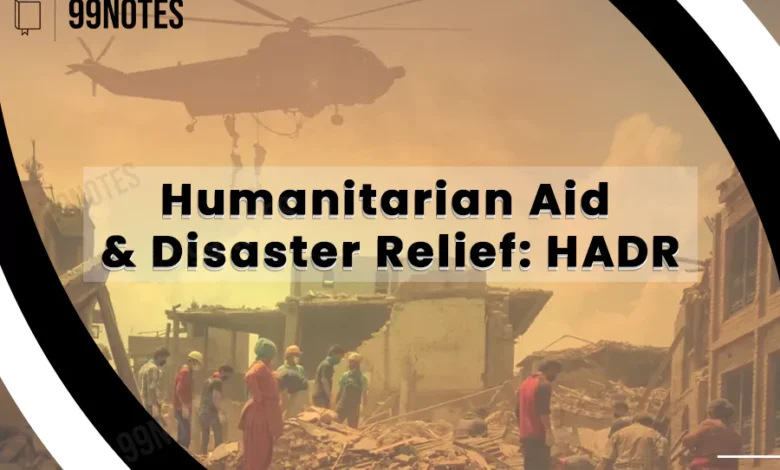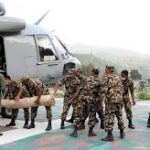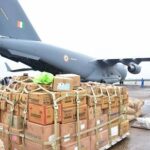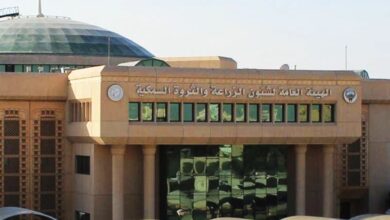A lifeline in crisis, India expands role in humanitarian assistance and disaster relief
India is cementing its position as a pivotal force in Humanitarian Assistance and Disaster Relief (HADR), drawing on its strategic location, economic strength, and advanced military capacity to deliver swift and dependable support in times of crisis. Through a blend of bilateral cooperation, multilateral initiatives, joint exercises, and rapid deployments, India has earned the trust of its neighbors, strengthened regional stability, and established itself as both a preferred first responder in humanitarian emergencies and a credible partner in global relief efforts.

India’s growing presence in Humanitarian Assistance and Disaster Relief (HADR) reflects both its emergence as a major economic power and its ambition to take on a leadership role in regional and global affairs. Over recent decades, India has increasingly positioned itself as a dependable “first responder” in South Asia—one of the world’s most disaster-prone regions.
Since 1970, South Asia has witnessed a fivefold increase in natural disasters, with estimated direct economic losses of more than US$80 billion. The region is the most exposed globally to flooding, the second most vulnerable to cyclones, and has endured the highest disaster-related fatalities due to earthquakes. Against this backdrop, India’s proactive HADR posture has become a cornerstone of its regional engagement strategy.
A substantial share of India’s development assistance, including humanitarian relief, is directed toward its immediate neighborhood in South Asia. Its outreach extends further to Southeast Asia and, increasingly, to other regions across the globe. This reflects a combination of humanitarian commitment and strategic diplomacy.
In 2019, India’s Minister of Home Affairs, Amit Shah, emphasized this commitment by stating: “In the Indian sub-continent, we have been playing the role of the first responder in the case of disaster… India is leading the initiatives in disaster management and disaster resistance.” Such declarations, backed by India’s growing capabilities, have raised expectations of its leadership during crises.
India’s HADR journey came into sharp focus during the 2004 Indian Ocean tsunami. Despite being one of the worst-affected countries, India declined foreign aid and instead extended assistance to Sri Lanka and the Maldives. This moment proved to be a turning point in India’s policy, setting a precedent for future regional and international relief operations.
Subsequent missions included aid to Bangladesh after Cyclone Sidr and to Myanmar following Cyclone Nargis. In the case of Myanmar, the acceptance of Indian assistance—while rejecting Western offers—highlighted India’s credibility as a regional humanitarian actor distinct from traditional donors.
Perhaps the most extensive demonstration of India’s HADR capacity was Operation Maitri, launched in response to the devastating April 2015 Nepal earthquake. The quake, measuring 7.8 in magnitude, killed nearly 8,900 people and caused avalanches on Mount Everest.
Within hours, India dispatched a large civil-military contingent, including the Indian Army, Air Force, and Gurkha ex-servicemen. Indian teams rescued stranded climbers, recovered bodies, and evacuated survivors from Everest base camp.
The Indian Air Force (IAF) mobilized a wide range of assets—from Ilyushin Il-76 and C-17 Globemaster aircraft to Advanced Light Helicopters and Mi-17 helicopters—delivering relief supplies and evacuating victims. This large-scale operation demonstrated India’s ability to deploy resources swiftly and effectively in complex environments.
Over time, India has directed more than two-thirds of its humanitarian aid to South Asia. Relief efforts have supported responses to the Cyclones Mora and Nargis, the 2014 Maldivian water crisis, and the 2018 Rohingya refugee emergency.
In 2017, India launched Operation Insaniyat to support Bangladesh and Myanmar during multiple humanitarian crises. Between 2017 and 2019, India provided over US$6.4 million in relief to Myanmar for Rohingya refugees. Such assistance reinforced India’s commitment to balancing humanitarian duty with regional diplomacy.
Most recently, India undertook Operation Brahma following the 2025 Myanmar earthquake. The Indian Army established a 60-bed medical treatment center for trauma and surgical care, while the IAF airlifted 15 tons of relief material. An 80-member National Disaster Response Force (NDRF) team was deployed to Nay Pyi Taw, while the Indian Navy dispatched five vessels carrying 52 tons of HADR supplies. Despite challenges, including GPS spoofing incidents targeting IAF aircraft, India’s relief mission demonstrated resilience and adaptability in modern disaster contexts.
India’s humanitarian instincts were also on display after the Bangladesh Air Force aircraft crash of July 21, 2025, which killed at least 20 students and teachers and injured over a hundred others. Within hours, New Delhi offered medical assistance. A team of burn-specialist doctors and nurses, equipped with life-saving supplies, was dispatched to Dhaka to provide emergency care.
The Ministry of External Affairs noted that further medical teams and even transfers of critical patients to India were being planned.
India’s evolving HADR framework is no longer limited to natural disasters. It now extends to pandemics, industrial accidents, and complex emergencies. During the COVID-19 pandemic, India supplied free medicines, testing kits, and protective equipment to 82 countries across Asia, Africa, and Latin America. This not only reinforced its role as a responsible global actor but also displayed its capacity to mobilize resources during an unprecedented crisis.
The Development Partnership Administration (DPA) of the Ministry of External Affairs coordinates India’s overseas relief operations, working with the Ministry of Defence and regional states. Since 2011–12, the Union Budget has carried a dedicated line for “Aid for Disaster Relief.” Upon request, the DPA mobilizes inter-ministerial resources, while the Integrated Defence Staff Headquarters deploys assets from the Army, Navy, Air Force, and Coast Guard.
Domestically, the creation of the National Disaster Management Authority (NDMA) in 2005 and the National Policy on Disaster Management (NPDM) in 2009 helped strengthen institutional capacity. While NDMA’s mandate is primarily national, it has frequently supported international missions. Its specialized force, the NDRF, continues to be the spearhead of India’s overseas relief deployments.
India’s expanding humanitarian role underscores a strategic blend of compassion and capability. As South Asia and beyond face escalating climate risks, pandemics, and complex emergencies, India’s record as a reliable first responder not only protects vulnerable communities but also cements its aspirations for regional leadership and global responsibility.
Follow The Times Kuwait on X, Instagram and Facebook for the latest news updates















